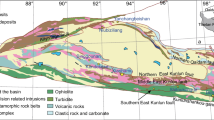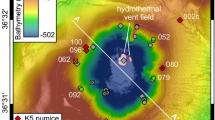Abstract
The geochemistry and mineralogy of a condensed section, ~6 m thick of the West Kasrik member (Coniacian–Santonian) near the uplifted northern flank of the Mardin–Derik anticline (south-eastern Turkey) was studied. The only deposit exploited in Turkey is found in this area. The sediment textures as well as the mineralogical and the geochemical results collectively suggest that these recycled phosphorites accumulated in areas of intensive very early diagenesis of the sediments in highly oxic bottom waters, and almost no detrital apport. The total concentration of redox-sensitive trace metals is very low (<600 μg/g); in addition the structural CO2 and F/P2O5 are unusually high (~5 wt % and 0.14, respectively). REE distribution shows a clear “seawater” pattern with a strongly negative Ce-anomaly (0.20 ± 0.02) and heavy REE enrichment (LuN/LaN = 1.50 ± 0.12), however their total concentration is very low. The low REE contents, quite unexpected in recycled phosphorites, are explained by the scarcity of terrigenous components which leads to minimal incorporation of REEs from detrital clastic phases in the CFA fraction. Weathering previously suggested as responsible for the high P enrichment of the Mazidagi phosphorites is rather improbable in the samples we studied, in view of their high structural CO2, high F/P2O5, high (La/Nd)N and (La/Sm)N ratios, and high Sr/P and Ca/P of separated CFA fractions that all negate post-depositional weathering. More likely, the high P enrichment of some rocks (P2O5 content reaches 34%) was produced by sedimentary and early diagenetic processes acting in oxygenated areas of starved sedimentation on and around tectonic highs.








Similar content being viewed by others
References
Altschuler ZS (1980) The geochemistry of trace elements in marine phosphorites; Part 1, Characteristic abundances and enrichment. In: Bentor YK (ed) Marine phosphorites: geochemistry, occurrence, genesis. Special Publication, Society of Economic Paleontologists and Mineralogists 29:19–30
Barron EJ, Harrison CGA, Sloan JLII, Hay WW (1981) Paleogeography, 180 million years ago to the present. Eclogae Geol Helv 74:443–470
Berker E (1971) Phosphate researchers and studies of the West Kasrik area in Mardin-Mazidagi. Mineral Research and Exploration Institute, Ankara. Report 4545:5–45
Berker E (1977) Phosphate exploration and occurrences in Turkey. In: Notholt AJG (ed) Phosphate rock in the CENTO region (Iran, Pakistan and Turkey), Ankara: Central Treaty Organization, pp 99–125
Berker E (1989) The Mardin-Mazıdağı-Derik phosphate deposits, south east Turkey. In: Notholt AJG, Sheldon RP, Davidson DF (eds) Phosphate deposits of the world. Phosphate rock resources, vol 2. Cambridge University Press, Cambridge, pp 380–386
Berker E, Sincil M (1971) Phosphate exploration in Turkey. Annex A to paper EC/20/M/D, CENTO unpublished report. Ankara: Central Treaty Organization, 37 pp
Bonnot-Courtois C, Flicoteaux R (1989) Distribution of rare-earth and some trace elements in Tertiary phosphorites from the Senegal basin and their weathering products. Chem Geol 75:311–328. doi:10.1016/0009-2541(89)90004-1
Bosworth W, Guiraud R, Kessler LGII (1999) Late Cretaceous (ca. 84 Ma) compressive deformation of the stable platform of northeast Africa (Egypt): far-field stress effects of the “Santonian event” and origin of the Syrian arc deformation belt. Geology 27:633–636. doi :10.1130/0091-7613(1999)027<0633:LCCMCD>2.3.CO;2
Çoban H, Varol B (2001) Sedimantological investigation of phosphate beds of Derik-Mazıdağ (Mardin) area, SW Turkey. Fourth International East Mediterranean Geology Symposium, 24–28 May, Isparta, Turkey, Abstract p 143
Cullen DJ, Burnett WC (1986) Phosphorite associations on sea-mounts in the tropical southwest Pacific Ocean. Mar Geol 71:215–236. doi:10.1016/0025-3227(86)90071-X
de Baar HJW, Bacon MP, Brewer PG (1985) Rare earth elements in the Pacific and Atlantic oceans. Geochim Cosmochim Acta 49:1943–1959. doi:10.1016/0016-7037(85)90089-4
Elderfield H, Greaves MJ (1982) The rare earth elements in seawater. Nature 296:214–219. doi:10.1038/296214a0
Föllmi KB (1990) Condensation and phosphogenesis: example from the Helvetic mid-Cretaceous (northern Tethyan margin). In: Notholt AJG, Jarvis I (eds), Phosphorite research and development, Geological Society of London Special Publication 52: 237–252
German CR, Elderfield H (1990) Application of the Ce anomaly as a paleoredox indicator: the ground rules. Paleoceanography 5:823–833. doi:10.1029/PA005i005p00823
Glenn CR, Föllmi KB, Riggs SR, Baturin GN, Grimm KA, Trappe J et al (1994) Phosphorus and phosphorites: sedimentology and environments of formation. Eclogae Geol Helv 87:747–788
Gradstein FM, Agterberg FP, Ogg JG, Hardenbol J, Van Veen P, Thierry J et al (1995) A Triassic, Jurrassic and Cretaceous time scale. SEPM Spec Publ 54:95–126
Gromet LP, Dymek RF, Haskin LA, Korotev RL (1984) The “North American shale composite”: its compilation, major and trace element characteristics. Geochim Cosmochim Acta 48:2469–2482. doi:10.1016/0016-7037(84)90298-9
Guldbrandsen RA (1970) Relation of carbon dioxide content of apatite of the Phosphoria Formation to regional facies. US Geol Surv Prof Pap 700B:9–13
Heimbach W, Shoukay B, Steiner S (1974) Die Phosphat-Lagerstatte Mazidagi, SE Turkei. Bundesantalt fur Bodenforshung (unpublished), quoted by Lucas et al. 1979
Hein JR, Yeh HW, Gunn SH, Sliter WV, Benninger LM, Wang CH (1993) Two major Cenozoic episodes of phosphogenesis recorded in Equatorial Pacific seamounts deposits. Paleoceanography 8:293–311
Hiatt EE, Budd DA (2003) Extreme paleoceanographic conditions in a Paleozoic oceanic upwelling system: organic productivity and widespread phosphogenesis in the Permian Phosphoria Sea. In: Chan MA, Archer AW (eds) Extreme depositional environments: mega end members in geologic time. Geolog Soc America, Special Paper, Boulder, Colorado 370:245–264
Jarvis I (1992) Sedimentology, geochemistry and origin of phosphatic chalks, the Upper Cretaceous deposits of NW Europe. Sedimentology 39:55–97. doi:10.1111/j.1365-3091.1992.tb01023.x
Jarvis I, Burnett WC, Nathan Y, Almbaydin FSM, Attia AKM, Castro LN et al (1994) Phosphorite geochemistry: state-of-the-art and environmental concerns. Eclogae Geol Helv 87:643–700
Jasinski SM (2003) Phosphate rock. US Geological Survey Minerals Yearbook, pp 56.1–56.5
Jones B, Manning DAC (1994) Comparison of geochemical indices used for the interpretation of palaeoredox conditions in ancient mudstones. Chem Geol 111:111–129. doi:10.1016/0009-2541(94)90085-X
Lucas J, Prevot-Lucas L (1996) Tethyan phosphates and bioproductites. In: Nairn AEM, Ricou LE, Vrielynk B, Dercourt J (eds) The Tethys Ocean. In the collection: the ocean basins and margins 8:367–391
Lucas J, Prevot L, Ataman G, Gundogdu N (1979) Etude Mineralogique et geochimique de la serie phosphate du Sud-Est de la Turquie (Mazidagi-Mardin). Bulletin Sciences Geologiques, Universite de Strasbourg, 32, 1–2:59–68
McArthur JM (1980) Post-depositional alteration of the carbonate-fluprapatite phase of Moroccan phosphates. In: Bentor YK (ed) Marine phosphorites: geochemistry, occurrence, genesis. Special Publication, Society of Economic Paleontologists and Mineralogists, 29:53–60
McArthur JM (1985) Francolite geochemistry—compositional controls during formation, diagenesis, metamorphism and weathering. Geochim Cosmochim Acta 49:23–35. doi:10.1016/0016-7037(85)90188-7
Nathan Y, Soudry D, Levy Y, Shitrit D, Dorfmann E (1997) Geochemistry of cadmium in the Negev phosphorites. Chem Geol 142:87–107. doi:10.1016/S0009-2541(97)00078-8
Notholt AJG, Sheldon RP, Davidson DF (1989) Phosphate deposits of the World. Phosphate rock resources, vol 2. Cambridge University Press, Cambridge
Papastavrou SE (1989) The phosphate resources of the Ipiros Province, Ionian zone, north-eastern Greece. In: Notholt AJG, Sheldon RP, Davidson DF (eds) Phosphate deposits of the world. Phosphate rock resources., vol 2. Cambridge University Press, Cambridge, pp 415–421
Piper DZ, Perkin RB, Rowe HD (2007) Rare-earth elements in the Permian Phosphoria Formation: Paleo proxies of ocean geochemistry. Deep Sea Res Part II Top Stud Oceanogr 54:1396–1413. doi:10.1016/j.dsr2.2007.04.012
Pitsikas L, Pomoni-Papaioannou F, Skourtsi-Koroneou V (1988) Phosphate formations in the Ionian zone. Bull Geol Soc Greece 20(2):343–361
Pomini-Papaioannou F (2001) Lithostratigraphy, sedimentology of the Upper Cretaceous phosphatic formations of the Ionian Zone: mechanism of phosphatization, paleotectonic frame. National and Kapodistrian University of Athens, Edition of the Department of Geology, Gaia 9:182
Reynard B, Lécuyer C, Grandjean P (1999) Crystal-chemical controls on rare-earth element concentrations in fossil biogenic apatites and implications for paleoenvironmental reconstructions. Chem Geol 155:231–241. doi:10.1016/S0009-2541(98)00169-7
Serjani A (1991) On the extension and lithological-facial composition of the Upper Cretaceous phosphatic horizon in the Ionian Zone. Geol Balk 21(1):59–68
Serjani A (1994) Phosphorites of Albania. Bull Geol Soc Greece 30:287–293
Shaw HF, Wasserburg GJ (1985) Sm–Nd in marine carbonates and phosphates: Implications for Nd isotopes in seawater and crustal age. Geochim Cosmochim Acta 49:503–518. doi:10.1016/0016-7037(85)90042-0
Sheldon RP (1964) Exploration for phosphorite in Turkey, A case history. Econ Geol 59:1159–1175
Shields G, Stille P (2001) Diagenetic constraints on the use of cerium anomalies as paleoseawater redox proxies: an isotopic and REE study of Cambrian phosphorites. Chem Geol 175:29–48. doi:10.1016/S0009-2541(00)00362-4
Soudry D, Nathan Y (2001) Diagenetic trends of fluorine concentration in Negev phosphorites: implications for carbonate fluorapatite composition during phosphogenesis. Sedimentology 48:723–743. doi:10.1046/j.1365-3091.2001.00392.x
Soudry D, Ehrlich S, Yoffe O, Nathan Y (2002) Uranium oxidation state and related variations in geochemistry of phosphorites from the Negev (southern Israel). Chem Geol 189:213–230. doi:10.1016/S0009-2541(02)00144-4
Soudry D, Glenn CR, Nathan Y, Segal I, VonderHaar D (2006) Evolution of Tethyan phosphogenesis along the northern edges of the Arabian–African shield during the Cretaceous-Eocene as deduced from temporal variations of Ca and Nd isotopes and rates of P accumulation. Earth Sci Rev 78:27–57. doi:10.1016/j.earscirev.2006.03.005
Soudry D, Nathan Y, Ehrlich S (2008) Geochemical diagenetic trends during phosphorite formation—economic implications: the case of the Campanian Mishash phosphorites, Negev, southern Israel. Sedimentology (in press)
Trappe J (1991) Stratigraphy, facies distribution and paleogeography of the marine Paleogene from the Western High Atlas, Morocco. N Jb Geol Paläont Abh 180:279–321
Tribovillard N, Algeo TJ, Lyons T, Riboulleau A (2006) Trace metals as paleoredox and paleoproductivity proxies: an update. Chem Geol 232:12–32. doi:10.1016/j.chemgeo.2006.02.012
Varol B (1989) Sedimentary petrography and origin of phosphate peloids of the Mazidag-Derik area (Mardin, southeast Turkey). Miner Res Exp Bull 109:65–73
Wedepohl KH (1991) The composition of the upper Earth’s crust and the natural cycles of selected metals. Metals in natural raw materials. Natural resources. In: Merian E (ed) Metals and their compounds in the environment. VCH, Weinheim, pp 3–17
Acknowledgments
This study was supported by the United States–Israel Binational Science Foundation (BSF), grant 1999232, the Geological Survey of Israel, GSI Project 40030, and the University of Hawaii School of Ocean and Earth Science and Technology. The authors are grateful to two anonymous reviewers for their comments which helped to improve the manuscript. They thank C. Netzer-Cohen for the graphics and B. Katz for her careful linguistic editing.
Author information
Authors and Affiliations
Corresponding author
Rights and permissions
About this article
Cite this article
Sefik Imamoglu, M., Nathan, Y., Çoban, H. et al. Geochemical, mineralogical and isotopic signatures of the Semikan, West Kasrık “Turkish” phosphorites from the Derik–Mazıdağı–Mardin area, SE Anatolia. Int J Earth Sci (Geol Rundsch) 98, 1679–1690 (2009). https://doi.org/10.1007/s00531-008-0332-1
Received:
Accepted:
Published:
Issue Date:
DOI: https://doi.org/10.1007/s00531-008-0332-1




